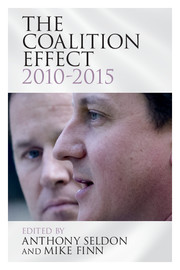Book contents
- Frontmatter
- Contents
- Contributors
- Acknowledgements
- David Cameron as Prime Minister, 2010–2015: The verdict of history
- Part I The coalition and the government of Britain
- 1 The coming of the coalition and the Coalition Agreement
- 2 The coalition and the constitution
- 3 The coalition beyond Westminster
- 4 The coalition and the executive
- 5 The coalition and Parliament
- Part II The coalition and policy
- Part III The coalition and political culture
- Part IV Conclusion
- Index
5 - The coalition and Parliament
Published online by Cambridge University Press: 05 April 2015
- Frontmatter
- Contents
- Contributors
- Acknowledgements
- David Cameron as Prime Minister, 2010–2015: The verdict of history
- Part I The coalition and the government of Britain
- 1 The coming of the coalition and the Coalition Agreement
- 2 The coalition and the constitution
- 3 The coalition beyond Westminster
- 4 The coalition and the executive
- 5 The coalition and Parliament
- Part II The coalition and policy
- Part III The coalition and political culture
- Part IV Conclusion
- Index
Summary
By the time of the 2010 election, Parliament – and especially the House of Commons – was widely seen as a battered and bruised institution, ‘on its knees’ in the words of one article on the subject. The expenses scandal of the year before had forced the Commons Speaker, Michael Martin, from office, and seen the institution suffer what his replacement, John Bercow, described as ‘reputational carnage’. ‘I cannot think of a single year in the recent history of Parliament’, Bercow claimed, ‘when more damage has been done … with the possible exception of when Nazi bombs fell on the chamber in 1941.’
Both the Commons and the Lords had rapidly taken measures to reform their expenses regimes, but given the widespread anti-politics mood that the scandal generated it was not surprising that all the main parties' election manifestos included further proposals for more widespread political reform, couched in terms of cleaning up politics. The resulting post-election Conservative–Lib Dem Coalition Agreement included a sizeable section on political reform, of which much directly related to Parliament. Had the Coalition Agreement been implemented in full, Parliament by 2015 could have looked very different from the institution elected in 2010. Elected to five-year fixed terms, the Commons would have been a smaller body with more equally sized constituencies. It could have been elected by the Alternative Vote, and would have had control over its own timetable. Members of the public would have had the power to initiate recall against MPs accused of wrong-doing and to initiate proceedings in the Commons, including bringing forward Bills. There would have been widespread all-postal primaries to select candidates for election. And there would have been the first steps towards a wholly or at least mainly elected House of Lords.
Almost none of this occurred. Most of the reforms died, from neglect or abuse. Where they survived, they were often a pale imitation of what had first been promised.
- Type
- Chapter
- Information
- The Coalition Effect, 2010–2015 , pp. 136 - 156Publisher: Cambridge University PressPrint publication year: 2015
- 3
- Cited by



